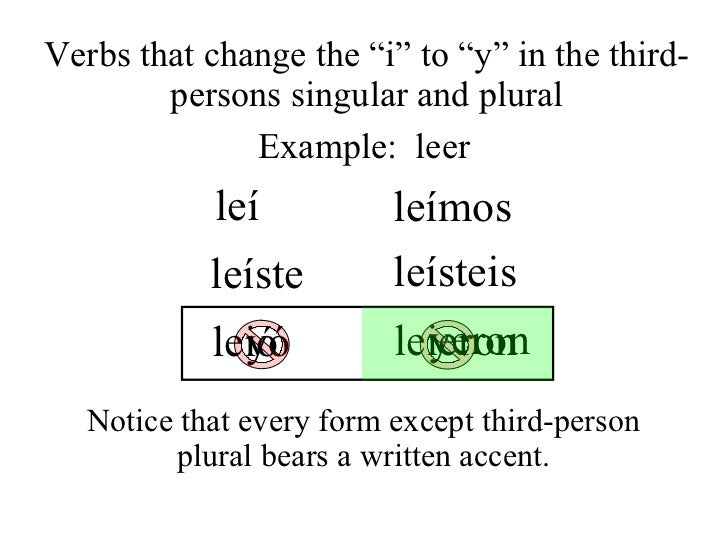

Click on the bottom right-hand corner to change Study Mode. Preterite Rules, Charts with regular and irregular rules explained and color-coded.Click on the top right-hand corner for Options.… Quizlet Activities – Preterite Past Tense YouTube/MrLearnSpanish: Verbs in the Preterite.YouTube/SeñorJordan: Preterite Verbs (Part 1).

LEAF Spanish Verb Conjugation Chart: Verb Endings.❺ dónde bailaron ellos la semana pasada?Įllos bailaron en la escuela la semana pasada. Yesterday, I spoke with my neighbor (fem.) Here are some common verbs that are regular in the preterite tense! Nosotros hablamos : we spoke (preterite past tense) Nosotros hablamos : we speak (present tense) You’ll just have to use the context of the sentence in order to figure out what time frame is being discussed. For verbs ending in - ll/-ñ + -er/-ir, we remove the final - i in the 3 rd person singular and plural.Notice that the nosotros form,, is identical to the present tense nosotros form.Sometimes, we have to change the final consonant of certain -ar verbs in the 1 st person singular in order to preserve the pronunciation.Įxample: c becomes qu → atra car moor ( a ship) - atra qué g becomes gu → col gar hang, add - col gué gu becomes gü → averi guar investigate, research - averi güé z becomes c → empe zar begin - empe cé.For verbs ending in a vowel + -er/-ir, we change - i to a - y in the 3 rd person singular and plural form.Įxample: caer fall - caí, caíste, ca yó, caímos, caísteis, ca yeron distribuir distribute - distribuí, distribuiste, distribu yó, distribuimos, distribuisteis, distribu yeron leer read - leí, leíste, le yó, leímos, leísteis, le yeron oír hear - oí, oíste, o yó, oímos, oísteis, o yeron.The endings of these verbs are irregular (-e, -iste, -o, -imos, -isteis, -eron).Įxample: traducir translate - trad uje, trad ujiste, trad ujo, trad ujimos, trad ujisteis, trad ujeron Most of the tenses are the same, but the conjugation of verbs changes according to the. Verbs that end in - ucir, change - uc to -uj. The Spanish language has lots of conjugations that English does not have.Some - ir verbs, change their stem in the 3 rd person singular and plural (-e → -i, -o → -u).Įxample: p edir ask for - pedí, pediste, p idió, pedimos, pedisteis, p idieron d ormir sleep - dormí, dormiste, d urmió, dormimos, dormisteis, d urmieron.We know from the context which verb is meant. The verbs ser and ir are identical in the preterite tense.Vine, viniste, vino, vinimos, vinisteis, vinieron Traje, trajiste, trajo, trajimos, trajisteis, trajeron Note that the nosotros form is the same as the present tense form. Tuve, tuviste, tuvo, tuvimos, tuvisteis, tuvieron To form the preterite in Spanish with regular verbs, remove the -ar, -ir, or -er and add the appropriate ending from the chart below. Supe, supiste, supo, supimos, supisteis, supieron Quise, quisiste, quiso, quisimos, quisisteis, quisieron Puse, pusiste, puso, pusimos, pusisteis, pusieron Pude, pudiste, pudo, pudimos, pudisteis, pudieron Hice, hiciste, hizo, hicimos, hicisteis, hicieron Hube, hubiste, hubo, hubimos, hubisteis, hubieron Preterite Conjugation ( yo, tú, él, nosotros, vosotros, ellos)Īnduve, anduviste, anduvo, anduvimos, anduvisteis, anduvieronĬupe, cupiste, cupo, cupimos, cupisteis, cupieronĭije, dijiste, dijo, dijimos, dijisteis, dijeronĮstuve, estuviste, estuvo, estuvimos, estuvisteis, estuvieron


 0 kommentar(er)
0 kommentar(er)
